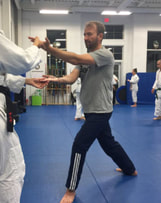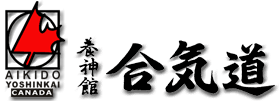
The following is from Sensei Chris Johnston, Shindokan Dojo
In Yoshinkan Aikido, the Kihon Dosa are considered to be a distillation of the key physical skills and principles inherent in everything we do. They include: Tai no Henko, Hiriki no Yosei, and Shumatsu Dosa. Each of these has a #1 and a #2, so this gives 6 movements altogether. They can be performed solo or in pairs. The #1 techniques emphasize entering (irimi) and the #2 techniques focus on pivoting (tenkan). All of the exercises train us to use smooth, centred and unified movements.
As an aside, I find the English name “Basic Movements” a little misleading. I prefer to translate the Japanese phrase — Kihon Dosa — as “Foundational Movements.” It seems to me that this gives a better transmission of the phrase’s full meaning.
Tai no Henko (Body Change) movements include cross-stepping in as you change directions, as well as guiding as you pivot. In the #1 movement — Cross-Step In Body Change — the hips are key in the change of directions as you step forward from your back foot. In the #2 — 95 Degree Pivot — the hips are used again to generate a stable guiding movement that pivots on the front foot. The use of the hips in both cases is the source of power and stability for the movements. The practice of these hips movements helps us to move in a stable, centred and, at the same time, circular manner. Tai no Henko movements also teach us to co-ordinate the movements of our arms, legs and body. When practicing these, be sure to move in a unified manner.
Tai no Henko teaches us that “going with the flow” from a position of strength can result in our success. Irimi (entering) and tenkan (pivoting) used at the appropriate times result in our strong position vis-a-vis the opponent. Give the opponent what they want . . . but win in the end.
The Hiriki no Yosei (Elbow Power) movements are said to come from the raising and cutting of a sword. In Yoshinkan Aikido, Hiriki no Yosei is a basic practice of moving your centre of gravity. Forward and backward is called #1 and shifting is called #2. It is important to keep in mind that this set is not called “Shoulder Power” or “Arm Power.” Keep the shoulders down and do not use the strength of your arms. Move with the power of your lower body as it is transferred from your feet through your knees and hips and along the lower part of your arms (triceps). Keep your weight on the balls of your feet and keep your back leg straight. Don’t fall down.
One of the things that Hiriki no Yosei teaches us is that aikido does not use muscle power. It uses unified and centred body power. The more we can focus the power of the entire body the more effective our technique will be. The more we can bring our entire beings to bear on a project or problem in life, the more effective we will be.
The final set, Shumatsu Dosa (Finishing Movement, After Class Exercise), are movements drawn from the Ryotemochi Shihonage technique. In the #1, the movement reinforces blending, entering, shifting, extending and the transfer of body power to the hands. The #2 movement emphasizes guiding and pivoting along with shifting, extending and power transfer. This set is the most complicated of the Kihon Dosa group both in terms of physical movement as well as integration of key principles. In the practice of Shumatsu Dosa you must bring all of these key concepts to bear. Make big movements, move sharply, step deeply and smoothly.
The lesson? In aikido, find a position that is at the same time strong for you and weak for the opponent. This is not achieved through confrontation and muscle, but rather through blending and guiding.
As I alluded to above, the Kihon Dosa are anything but basic. They are really the foundation of everything we study. Pay attention to every detail of these and your aikido will become extremely effective. I believe it is Robert Mustard Shihan who always says: “The way you do your basic movements is the way you will do you basic techniques. The way you do your basic techniques is the way you will do your freestyle.”
Seems basic enough.
Practice well!
OSU!
Chris Johnston
Chief Instructor, Shindokan Dojo
Aikido Yoshinkai Canada
In Yoshinkan Aikido, the Kihon Dosa are considered to be a distillation of the key physical skills and principles inherent in everything we do. They include: Tai no Henko, Hiriki no Yosei, and Shumatsu Dosa. Each of these has a #1 and a #2, so this gives 6 movements altogether. They can be performed solo or in pairs. The #1 techniques emphasize entering (irimi) and the #2 techniques focus on pivoting (tenkan). All of the exercises train us to use smooth, centred and unified movements.
As an aside, I find the English name “Basic Movements” a little misleading. I prefer to translate the Japanese phrase — Kihon Dosa — as “Foundational Movements.” It seems to me that this gives a better transmission of the phrase’s full meaning.
Tai no Henko (Body Change) movements include cross-stepping in as you change directions, as well as guiding as you pivot. In the #1 movement — Cross-Step In Body Change — the hips are key in the change of directions as you step forward from your back foot. In the #2 — 95 Degree Pivot — the hips are used again to generate a stable guiding movement that pivots on the front foot. The use of the hips in both cases is the source of power and stability for the movements. The practice of these hips movements helps us to move in a stable, centred and, at the same time, circular manner. Tai no Henko movements also teach us to co-ordinate the movements of our arms, legs and body. When practicing these, be sure to move in a unified manner.
Tai no Henko teaches us that “going with the flow” from a position of strength can result in our success. Irimi (entering) and tenkan (pivoting) used at the appropriate times result in our strong position vis-a-vis the opponent. Give the opponent what they want . . . but win in the end.
The Hiriki no Yosei (Elbow Power) movements are said to come from the raising and cutting of a sword. In Yoshinkan Aikido, Hiriki no Yosei is a basic practice of moving your centre of gravity. Forward and backward is called #1 and shifting is called #2. It is important to keep in mind that this set is not called “Shoulder Power” or “Arm Power.” Keep the shoulders down and do not use the strength of your arms. Move with the power of your lower body as it is transferred from your feet through your knees and hips and along the lower part of your arms (triceps). Keep your weight on the balls of your feet and keep your back leg straight. Don’t fall down.
One of the things that Hiriki no Yosei teaches us is that aikido does not use muscle power. It uses unified and centred body power. The more we can focus the power of the entire body the more effective our technique will be. The more we can bring our entire beings to bear on a project or problem in life, the more effective we will be.
The final set, Shumatsu Dosa (Finishing Movement, After Class Exercise), are movements drawn from the Ryotemochi Shihonage technique. In the #1, the movement reinforces blending, entering, shifting, extending and the transfer of body power to the hands. The #2 movement emphasizes guiding and pivoting along with shifting, extending and power transfer. This set is the most complicated of the Kihon Dosa group both in terms of physical movement as well as integration of key principles. In the practice of Shumatsu Dosa you must bring all of these key concepts to bear. Make big movements, move sharply, step deeply and smoothly.
The lesson? In aikido, find a position that is at the same time strong for you and weak for the opponent. This is not achieved through confrontation and muscle, but rather through blending and guiding.
As I alluded to above, the Kihon Dosa are anything but basic. They are really the foundation of everything we study. Pay attention to every detail of these and your aikido will become extremely effective. I believe it is Robert Mustard Shihan who always says: “The way you do your basic movements is the way you will do you basic techniques. The way you do your basic techniques is the way you will do your freestyle.”
Seems basic enough.
Practice well!
OSU!
Chris Johnston
Chief Instructor, Shindokan Dojo
Aikido Yoshinkai Canada


 RSS Feed
RSS Feed